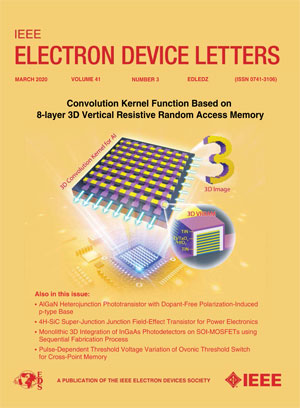反向偏置应力下多晶硅/4H-SiC功率异质结场发射隧穿电流的异常减小
IF 4.5
2区 工程技术
Q2 ENGINEERING, ELECTRICAL & ELECTRONIC
引用次数: 0
摘要
实验首次证明了低势垒多晶硅/4H-SiC异质结的可靠性,在500 a /cm2正向电流密度和1 mv /cm反向电场下分别具有优异的长期正向导通和反向阻断可靠性,这对功率应用至关重要。在1.2 kv级的4H-SiC薄膜上制备了纯功率异质结,势垒高度为0.804 eV,理想系数为1.026。创新地发现异质结反向电流(${I}_{\text {R}}\text{)}$随反向偏置应力时间异常减小,而没有任何正向电参数退化。通过对异质结场发射(FE)隧穿过程的建模和缺陷密度的提取,证明了反向电场会激活深层受体型界面缺陷,从而捕获电子并阻碍反向FE隧穿电流。研究结果可以促进Poly-Si/4H-SiC异质结的功率应用,并为所有异质结器件的烧蚀过程和可靠性评估提供指导。本文章由计算机程序翻译,如有差异,请以英文原文为准。
Anomalous Decrease of Field-Emission Tunneling Current for Poly-Si/4H-SiC Power Heterojunction Under Reverse Bias Stress
The reliability of the low-barrier Poly-Si/4H-SiC heterojunction is experimentally demonstrated for the first time, with a superior long-term forward conduction and reverse blocking reliability under the 500-A/cm2 forward current density and the 1-MV/cm reverse electric field, respectively, which is critical for power applications. The pure power heterojunction is fabricated on a 1.2 kV-class 4H-SiC epilayer, featuring a barrier height of 0.804 eV and a great ideality factor of 1.026. It is innovatively discovered that the heterojunction reverse current ( ${I}_{\text {R}}\text {)}$ anomalously decreases with the reverse bias stress time without any forward electrical parameter degradation. By modelling the heterojunction field-emission (FE) tunneling and extracting the defect density, it is demonstrated that the deep-level acceptor-type interface defects are activated by the reverse electric field, which will capture electrons and impede the reverse FE tunneling current. The research results can promote the power applications of the Poly-Si/4H-SiC heterojunction and provide guidelines for all heterojunction devices in the burn-in process and the reliability evaluation.
求助全文
通过发布文献求助,成功后即可免费获取论文全文。
去求助
来源期刊

IEEE Electron Device Letters
工程技术-工程:电子与电气
CiteScore
8.20
自引率
10.20%
发文量
551
审稿时长
1.4 months
期刊介绍:
IEEE Electron Device Letters publishes original and significant contributions relating to the theory, modeling, design, performance and reliability of electron and ion integrated circuit devices and interconnects, involving insulators, metals, organic materials, micro-plasmas, semiconductors, quantum-effect structures, vacuum devices, and emerging materials with applications in bioelectronics, biomedical electronics, computation, communications, displays, microelectromechanics, imaging, micro-actuators, nanoelectronics, optoelectronics, photovoltaics, power ICs and micro-sensors.
 求助内容:
求助内容: 应助结果提醒方式:
应助结果提醒方式:


